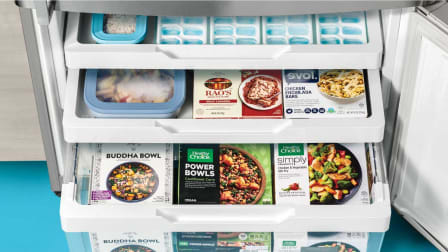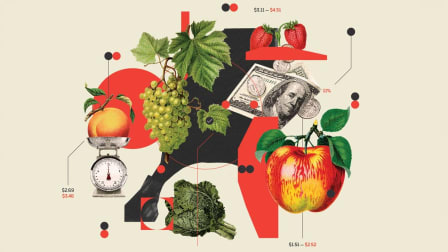How to Save Money Food Shopping
With food prices rising, here are 19 ways to optimize your shopping dollars at the grocery store

Many of us have a basketful of grocery shopping tactics we use to save money. We buy cheaper cuts of meat. We avoid pricey processed foods. We choose store brands over more expensive name brands. Some of us might even go the extra mile, shopping at multiple supermarkets each week to get the best deals at each of them.
It’s no wonder. Though inflation is cooling, food prices are still up 3.7 percent over a year ago, according to the Bureau of Labor Statistics’ most recent Consumer Price Index report. And most economic projections do not foresee prices falling to anywhere near where they used to be anytime soon.
Finding Tactics That Work
Use these tactics from experts and CR’s Facebook followers to shave dollars off your bill. Some not only will save you money but also could lead you to healthier eating.
1. Find alternative protein sources. For example, beans and other legumes remain a good nutrition bet that is lower cost, says Amy Keating, RD, a registered dietitian who oversees Consumer Reports’ food testing. “They are linked to many health benefits, are inexpensive, and are a great alternative source of protein,” she says. Check out CR’s ideas for other tasty meatless options.
Adding more egg-based recipes to your repertoire is another option, Keating says. Fortunately, egg prices are down 14.5 percent since last year, making them a relatively inexpensive and extremely versatile protein.
2. Frequent low-cost grocers. Flickinger gives a particular shoutout to membership clubs BJ’s and Costco, which are able to keep their prices lower thanks to the big volume discounts they receive from suppliers. He also thinks Target and Walmart are great places to save on food. If you can get into, or know someone with access to, the Department of Defense’s Commissary, take advantage. Commissary, which serves active and retired military personnel, strictly limits its markups. (Eligibility to this nationwide grocer was expanded in January 2020.)
3. Plan before you shop. Make a list and stick to it. This can reduce impulse purchases and save time. A good place to start is by perusing grocery circulars, which typically are available online. “If you can save $30 by spending 15 minutes looking at grocery ads, is it worth it?” asks Annette Economides of Scottsdale, Ariz., who with her husband, Steve, runs the website MoneySmartFamily. “I certainly think it is.”
Another way to stick to a list: “Use a store’s curbside pickup service, which removes the temptation to stray from your list,” Economides says. Or have groceries delivered, but only after checking store policies to make sure you stay on the right side of the deal. “Walmart offers the service for free, but Amazon via Whole Foods charges a fee for orders under $35 and Aldi also adds a small delivery fee,” Economides says.
4. Use a store loyalty card. Most grocery chains’ loyalty programs offer special member deals. Some, notably those of Safeway and Stop & Shop, also let you build rewards toward gas purchases at affiliated gas stations. In addition, store loyalty cards are often a portal to digital-only coupons that aren’t printed in circulars but can be downloaded and applied when you use your loyalty card.
5. Utilize shopping apps. Download your favorite store’s app to find this week’s sales and coupons. Also, look into independent apps; three we like are Basket, Ibotta, and Flipp. Basket shows real-time grocery prices online and in-store at local grocers, so you can see where to shop for the best deals; it crowdsources its data, the same way a traffic app like Waze works. Ibotta and Flipp both identify manufacturer promotions and coupons, and offer direct rebates after you buy from a participating retailer. The Flipp app also lets you attach store loyalty cards to your profile so that you won’t have to remember to bring a physical card on your next shopping trip.
6. Compare unit prices. Unit price shelf stickers under each product can help you better compare prices of like items. But if the store doesn’t have the stickers, download a unit price calculator on your smartphone to do the work for you: We found free ones for both iOS and Android phones.
7. Go with store brands. Store-brand food and beverage products—also called private label—can cost 20 to 25 percent less than name brands of the same product. (When CR members were surveyed about the grocery stores and supermarkets they liked best, three grocers earned top marks for their store brands: national names Costco and Trader Joe’s, and Central Market, which is based in San Antonio and is a subsidiary of the privately owned H-E-B supermarket chain.) You can often find store brands on shelves just to the right or left of comparable name-brand items.
8. Use a cash-back credit card. Some offer rewards for grocery purchases. If you’re looking for a new one, consider the American Express Blue Cash Preferred card; it returns 6 percent on the first $6,000 in groceries each year, among other benefits. The card is currently offering a $300 rebate for spending $3,000 in the first six months, and the $95 annual fee is waived for the first year. Keep in mind that you may need a credit score of 700 or higher to qualify, says Ted Rossman, an industry analyst at CreditCards.com. The annual percentage rate on this card ranges from 14 percent to 24 percent, so it’s best to use it only if you can pay off your balance each month.
9. Embrace coupons. Stores may double or even triple the value of manufacturers’ coupons at checkout. In the Northeast, for instance, Stop & Shop doubles manufacturers’ paper coupons, under 99 cents, every day (restrictions apply).
10. Focus on reducing food waste. A four-person family could lose at least $1,500 per year on wasted food, says the Natural Resources Defense Council. Check out the organization’s SaveTheFood hub for numerous tips and tools on how to reduce food waste and save money, and read in CR how an expert optimizes the items in her fridge and pantry. Also, use the free FoodKeeper app from the Department of Agriculture for guidelines on how to store foods.
11. Get senior discounts. Harris Teeter and Hy-Vee offer 5 percent discounts, either on specific days or when you present a special store ID card. Fred Meyer and New Seasons Market discounts are 10 percent. In some cases, you can be as young as 55 to qualify; in other cases, you’ll need to be at least 60. The discount may be available only on certain days or on select items. If you’re one of the 6.4 million seniors enrolled in Medicaid, you can get a subscription to Amazon Prime at half the $14.99 monthly fee, and are eligible for discounted pricing at Whole Foods.
12. Buy in bulk. When 10 cans of your favorite soup go on sale for $10, it’s always wise to load up. And larger packages often have lower per-unit pricing. WinCo Foods, based in Boise, Idaho, is one notable vendor of such products, selling low-cost bulk barrels and bins of dried fruits, pasta, spices, snacks, legumes, nuts, candies, and other items.
13. Barter and share. If you buy in bulk or find yourself with more of some items than you need, consider trading with neighbors and friends. Economides from MoneySmartFamily says she has bartered the citrus that grows on her property for food from folks she has found through a local Facebook gardening group. Early in the pandemic, for instance, she got a carton of eggs, which had been hard to come by, in return for oranges and rosemary that grow on her property. “It was a great deal for both of us,” she says.
14. Track prices. For a few weeks, record the prices of the items you buy the most when food shopping. You’ll be able to find the best prices for specific goods and can stock up when a true price drop happens. Price tracking also helps you see when a “10 packages for $10” sale really is a sale and not just a come-on.
15. Do the math on grocery delivery annual memberships. If you expect to use grocery delivery on a regular basis, calculate the value of an annual membership before you sign up. For instance, Instacart+ (formerly Instacart Express) costs $99 per year; you pay no additional delivery fee if your orders cost $35 or more. Minimum order fees are $3.99 outside of Instacart Express, so you’ll break even on the annual fee after 25 orders. (Over a year of use, that means you order about every two weeks.)
And while the Walmart+ fee is $12.95 a month after a 90-day free trial, you can get free shipping with a $35 order minimum.
16. Look for “as is” items. The overripe bananas you’ll find at a discount could be perfect for homemade banana bread. Learn where stores have their clearance sections, Economides says.
17. Grow your own. Yvette Beltran-Southwell, who lives north of Dallas, says her family grows rosemary, English thyme, two types of oregano, sage, Italian parsley, basil, and numerous other herbs to economize and reduce food waste. “I have a garden, but even when we were in a townhouse with limited space, I grew herbs outside in containers,” she says. Homegrown plants also last longer than bunches purchased at the store and refrigerated, she says. And, of course, they regenerate throughout the growing season.
18. Get creative with how you use, store, and eat food. “We choose recipes that are more plant-based, with meat as a side dish,” Beltran-Southwell says. “On occasion, we have breakfast for dinner because it’s fun and cheaper.” Linda Test of Mena, Ark., supplements meat servings with lentils and beans, and eats vegetarian twice a week, and uses up fresh fruits and vegetables in the order they go bad. “Salads and spinach are first,” she says. “Carrots or rutabaga are last.”
19. Use your freezer right. Freezing large quantities of sale and seasonal food saves the average family of four $2,000 per year, Economides says. Buying fresh blueberries in season, and stocking your freezer, is better than paying two to three times that much for frozen blueberries the rest of the year. The Economideses even freeze milk and cheese. Every 30 to 60 days, they check the freezer and build menus based on what’s there.
—Althea Chang-Cook, Margot Gilman, and Brian Vines contributed to this story




















